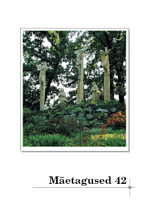Kristlike usuliikumiste mõju eestlaste ja eestirootslaste rahvakunstile ja kultuurile
The Impact of Christian Religious Movements on the Folk Art and Culture of Estonians and Estonian Swedes
Author(s): Jaanus PlaatSubject(s): Anthropology
Published by: Eesti Kirjandusmuuseum
Keywords: Estonian Swedes; folk art; folk culture; Moravian Brethren; religious movements
Summary/Abstract: In the 18th-19th century, several Protestant religious movements spread in Estonia. These movements were partly active within the so far predominant Lutheran Church, though mostly outside it, and were sometimes followed by members of the Orthodox Church. The most influential of the movements were the Brethren movement and that of ‘Heaven-goers’, and also the religious movements of awakening which spread mostly in the final quarter of the 19th century in western Estonia and which led to the establishment of the first Free Congregations in Estonia (Baptists, Irvingites, Free Believers’ congregations, Methodists). These religious movements have often contested several phenomena of folk culture of Estonians and Estonian Swedes, among these the phenomena of folk religion and folk art that some members of the movement have regarded as ‘pagan’ or sinful. As a result, fancier clothes, jewellery and musical instruments were destroyed in the heyday and the core areas of the movement (mostly in West Estonia); also, certain folk songs and dances of the agrarian community were abandoned and the narrative tradition underwent significant changes. The conflict with folk religion (with elements of prehistoric and Catholic beliefs) led to the destruction of prehistoric sacred sites and a dramatic change in the worldview of a part of the local peasantry. The 18th- to 19th-century Brethren movement was particularly successful in these activities. A characteristic feature of the Brethren congregation, the ‘Heaven-goers’, and other religious movements in the late 19th century was certain asceticism and requirement of high morals. The impact of these religious movements on folk culture, however, was limited only to the faithful and did not affect the entire village community. A more dramatic change in the beliefs and lifestyle of the people took place on the West-Estonian islands of Saaremaa and Hiiumaa, in Lääne County in West Estonia and, most noticeably, in the parish inhabited by Estonian Swedes. Even so, the sometimes hostile attitudes of the mentioned religious movements towards folk culture give no reason to underrate their significance and positive influence for the Estonian and Estonian-Swedish agrarian population of the time.
Journal: Mäetagused. Hüperajakiri
- Issue Year: 2009
- Issue No: 42
- Page Range: 7-32
- Page Count: 26
- Language: Estonian

